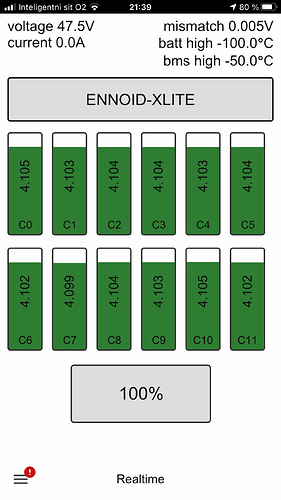Yes, it does work.
Sorry for that recent price hike, it is simply due to the fact that I’m struggling to keep up producing them. A lot of orders coming in and I’m also afraid about missing parts due to the global part shortage…I still have enough for now (still a few hundreds), but that might change fast at the actual pace… If someone here could get me some genuine LTC3639 ICs, that would be nice!
LTC3639, LTC7138 & LTC3638 are almost the only viable options for going above 100V …
Texas instrument’s LM5168 & LM5169 are not yet widely available and they are not as good.
NXP, ST, texas etc.
Get a chip that allows daisy chaining, putting them in series shouldn’t impose any issues really. (aslong as you bias ground correctly ofc. )
prob shortages all around but might open up for more options.
Well, you mean daisy chaining many XLITE-12 boards I guess. The actual balance IC being used on XLITEs can be daisy chained FYI…
LTC6811/LTC6804 and the firmware supports it already, but implementing that is a bit more complex than just saying it unfortunately.
if its on the same board or not dsn’t really matter ![]()
I’m currently designing a modular BMS for up to 405S (1500V), so been diggin into alot of chips recently.
Yeah, you might be right after all, I never thought really about this option. Just more regulator ICs… simply copy and paste most PCB by 12S modules and bring on higher and higher voltages. Will think about it a bit more, but sounds like a promising option during this part shortage.
There is still one main issue going distributed as you mentioned, using many voltage regulators instead of a single one and might explain why I discarded this option at first:
- Unless all regulators consume the exact same power amount, a small difference between first and others cells modules voltage will show up over time which will requires more balancing. MCU, CAN bus IC and power switches consume still a small amount of power and we do not want to duplicate those components for cost reasons and do not want to have voltage drop either on one particular module. I do not know any specialized voltage regulator that can be daisy chained either to get higher voltage operation. The balancing ICs on the XLITEs already have their own power regulator which is separate from the main power supply buck regulator.
Unless there is something I do not understand, this kills the idea mostly. The master & slave board topology/approach is out of question for XLITE boards. The only way of having all cell to keep their balance is to not disturb one particular group of cells.
This is the case for mutiple PCB structures too tho.
Not sure what specific parameter in terms of consumption you’re thinking about, but aslong as the design is equal for each part of the chain, that should have little to no impact. Furtheremore there are cell monitoring ICs that solely takes Vbat and does regulating magic within, (some Vref might be needed but that dsn’t really count as consumption). I see no reason for more then one voltage rail for the MCU(s) if the communication lines are isolated to the cell monitors.
Exactly, but the power needed for the MCU voltage rail must be taken somewhere.
To keep the whole pack balanced, you must take it from the main pack voltage otherwise you will create some unbalance in your pack.
Yeah I guess if thats really a quantifiable concern.
Using an external DC/DC for my BMS and the BMU nodes supply thier own power ![]()
BMU based on LTC68xx IC always had this self powering feature since probably 2010 and earlier. Buck regulator consumes power. Quiescent current is also a major concern om small bettery packs
Sure, my smallest module is 98 cells tho so not really a concern for me ![]()
Good sleep-mode design coupled with decent wake up SW will push down any idle draw when not in use.
I dont expect more then 300-500 microamps as most. With external wake-up we talking nanoamps
Yeah, your setup might be acceptable for some very large packs, but certainly not for a premium BMS for an eskate pack.
Aslong as the selfdischarge from the cells is alot larger then the sleep current, it really isn’t much of a concern ![]() Worth thinking about
Worth thinking about
Hi @ENNOID
XLITE12 BMS works fine but not getting anything on the CANBUS.
Do I need the CAN ENABLE connected to a VESC? Doesn’t seems to be working either way.
Baud rate is 500k on everything.
CANH & CANL must be connected to the VESC.
The CAN ENABLE+GND pins are necessary for waking up the EBMS with the VESC.
Other parameters on XLITE firmware are normally set properly by default to enable CAN with VESC like on the picture below:
Rebooted everything and it started working somehow ![]()
BMS data in VESC Tool is so fucking nice ![]()
Thanks Kevin!
Yes, and it will keep getting better over time, I’m slowly working on the next V5.04 release that should bring again some improvements with VESC compatibility. Ah & Wh counter more aligned with VESC BMS for example…
So just received my xlite 24s bms and Ennoid vesc. Thanks Kevin @ENNOID After some Startup issues (made a stupid mistake) my 16s setup seems to work ![]()







